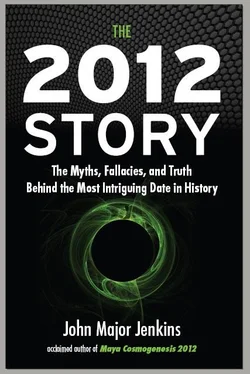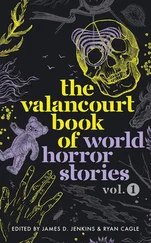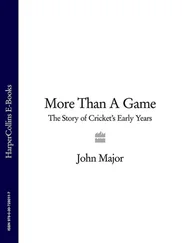John Major Jenkins
THE 2012 STORY
The Myths, Fallacies, and Truth Behind the Most Intriguing Date in History
Dreaming of clouds in Waxactun
angels grab my eyes
Peaceful stones transcend my reason
a shadowless noon
in the midsummer season
Defines this location as wise
Tropical moss enshrouds old stone
forgotten town decays
Soul sparks, long in tireless flight
arrive alone
on a moonless night
Upon the back of stellar rays
Time and fate will wait for you
to find eternal rest
When the world dissolves away
into the blue
of a dimming day
Just watch it all unmanifest 1
—JOHN MAJOR JENKINS Waxactun, Guatemala August 2008
2012: AN UNSTOPPABLE IDEA
This was the peopling of the face of the earth: They came into being, they multiplied, they had daughters, they had sons, these manikins, woodcarvings. But there was nothing in their hearts and nothing in their minds, no memory of their mason and builder. They just went and walked wherever they wanted… they did not remember the Heart of Sky. 1
—THE POPOL VUH
Writing this book was an immense undertaking that had to ac commodate new developments in the ever-shifting features of a quickly evolving field. Because of its curious crescendo in our immediate future, and therefore unlike any other topic, 2012ology (“twentytwelvology”) has been growing exponentially with a unique set of issues and attractions. This accelerating growth of interest in the public arena is driven primarily by urgent doomsday scenarios spun out by the mainstream media and opportunistic writers. And yet the date is not simply a newfangled gadget invented by the marketplace. It is, in fact, a true artifact of the authentic Maya calendar, which has suffered the cut-and-paste cos mologizing of wannabe wizards, pocket-protector prophets, and celebrity showmen. This heady stew is all stirred up in the Google cauldron, making a dangerous potion for the unsuspecting newcomer. As you step into this ever-shifting discussion, it will be helpful to have some historical background and a guiding survey of who has been saying what. This is part of what this book offers.
I’ve been investigating Maya culture since 1985, and I have written many research-oriented books and articles on Maya calendars and cosmology. My first two books were self-published travelogues peppered with historical facts and comments on the Mesoamerican worldview. I quickly became fascinated with various unresolved enigmas, including the 2012 cycle-ending date. My 1992 book, Tzolkin: Visionary Perspectives and Calendar Studies , presented my work on the Venus calendar found in the Dresden Codex, one of the few surviving Maya books. My 1998 book Maya Cosmogenesis 2012 broke new ground on identifying why 2012 was important to the ancient Maya, offering a new reconstruction of ancient Maya thought. Key questions were posed: When and where did the early Maya devise the calendar that gives us the cycle ending in 2012? Why did they place this cycle ending on December 21, 2012, and how did they think about it? These questions led me to discoveries and conclusions that integrated the domains of astronomy, mythology, prophecy, and spiritual teachings.
I found that a rare astronomical alignment culminates in the years leading up to 2012, when the position of the solstice sun will be aligned with the Milky Way galaxy. This solstice-galaxy alignment is a rare occurrence, happening only once every 26,000 years. It can be called a “galactic alignment” and was perceived by ancient astronomers as a shifting of the position of the sun, on the solstice, in relation to background features such as stars, constellations, and the Milky Way. Based on evidence in Maya traditions and key archaeological sites, it became overwhelmingly apparent to me that the future convergence of sun and galaxy was calculated, with good accuracy, by the ancient Maya and the cycle-ending date in 2012 was chosen to target it. Without going into any further questions and complexities, this situation means that the ancient Maya had astronomical abilities at least on par with their contemporaries in other parts of the world, including Greece, India, Babylo nia, and Egypt.
Importantly, I noticed that the astronomical features involved in the galactic alignment were key players in Maya cosmology and Creation Mythology. These connections were not free-floating opinions based on imagined associations that had no real relevance for the ancient Maya. In fact, the evidence was there in the academic literature itself. I was merely stitching all the pieces together. The solstice sun, the Milky Way, and a curious feature that lies along the Milky Way called the dark rift were utilized in the sacred ballgame, king-making rites, the calendar systems, and the Hero Twin Creation Myth. These real connections anchored the galactic alignment firmly within known Maya concepts and traditions. In my studies I quickly focused my attention on the early Maya site called Izapa, which scholars suspected as being involved in the formulation of the Long Count calendar. By 1994 the results of this approach had revealed Izapa as a critically important place for understanding how the Maya thought about the galactic alignment in era- 2012. Furthermore, the astronomy was woven together with spiritual teachings, conveyed as mythological dynamics in the Creation Myth on Izapa’s many pictographic monuments.
Astronomy, the calendar, and the Creation Myth were facets of the same cosmology. Beliefs about cycle endings, especially the big one in 2012, were represented in these traditions and revealed how the creators of the Long Count thought about 2012. It was not perceived as some dramatic doomsday apocalypse, as our modern media repeatedly prefers to portray it. Instead, the creators of the 2012 calendar utilized sophisticated spiritual teachings intended to facilitate a process of spiritual transformation and renewal. This was clearly big news, given that, in the mid-1990s when I made these discoveries, scholars had said nothing about 2012 and the doomsday interpretation was on the rise in the popular media. For me, the years after my first trip south of the border in 1986 were filled with exciting discoveries, continuing travels, field investigations at Maya sites, living and working with the modern Maya, meeting remarkable people, writing and teaching.
Through the years I’ve been invited to contribute articles to anthologies, speak at conferences, attend irresistible events, and conduct radio and TV interviews. Naturally, some of these were well produced, but others were ill conceived, and I’ve learned a lot about working with conference organizers and documentary producers. Throughout the aforementioned wonder-land of opportunities and farragoes my goal of finding a suitable publisher for a book telling the definitive 2012 story remained elusive. When the 2012 bug started to bite the mainstream press and many more books started to appear, I noticed that authors and the media were pulling the 2012 topic in predictably weird directions. For example, one prominent trend has involved slowly, and almost imperceptibly, divorcing the 2012 icon from its Maya roots. Another enlists 2012 into serving the dubious cause of fear-based doomsday scenarios populated by alien gene splicers, invisible planets, searing solar flares, and menacing asteroids. The vast majority of this unbridled superstorm of alarmist and hype-driven marketing ploys was problematic. I realized that I was in a unique position to offer clarity and discernment, so I got to work, building from scratch a new book that I envisioned to be the definitive 2012 story.
Читать дальше













